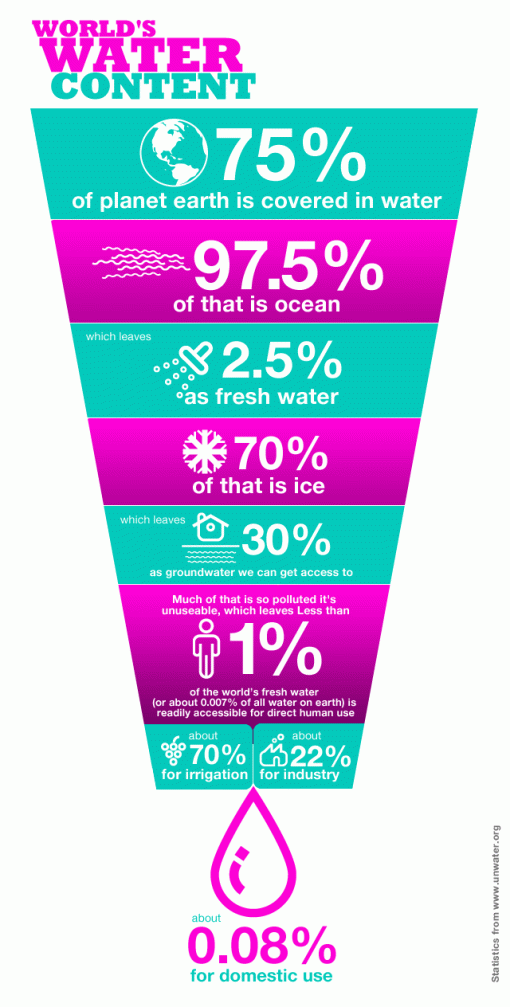Wordless Thursday – World water content
[tweetmeme]

[tweetmeme]

It’s the old myth heard time and again about how people use only ten percent of their brains. While for the people who repeat that myth, it’s probably true, the rest of us happily use all of our brains. That tired Ten-Percent claim pops up all the time. In 1998, national magazine ads for U.S. Satellite Broadcasting showed a drawing of a brain. Under it was the caption, “You only use 11 percent of its potential.” Well, they’re a little closer than the ten-percent figure, but still off by about 89 percent. In the beginning even I looked at that concept and thought of it as a plausible explanation for a lot of things including magic, psychic abilities etc.
[picapp align=”none” wrap=”false” link=”term=brain&iid=287909″ src=”0284/92a31411-b35a-4f7c-a5d9-efdaaeaae122.jpg?adImageId=12426315&imageId=287909″ width=”500″ height=”332″ /]
During the past few years and after various rounds of debates with friends, doctors and with engineers alike, I started to doubt it. One reason this myth has endured is that it has been adopted by psychics and other paranormal pushers to explain psychic powers. The biggest of these would be main stream media, there have been a few hundred movies showing psychics who have been seen saying “We only use ten percent of our minds. If scientists don’t know what we do with the other ninety percent, it must be used for psychic powers!” There have been even scores of books to those who are not exposed movies that time and again mention this tidbit saying that the rest is for the subconscious mind. Bollywood is not left far behind as well, Karthik calling Karthik was another movie which used this point.
The argument that psychic powers come from the unused majority of the brain is based on the argument from ignorance. In this Argument, lack of proof for a position (or simply lack of information) is used to try to support a particular claim. For example: Two people see a strange light in the sky. The first, a UFO believer, says, “See there! Can you explain that?” The skeptic replies that no, he can’t. The UFO believer is gleeful. “Ha! You don’t know what it is, so it must be aliens!” he says, arguing from ignorance. I am not a person who would say that UFO’s dont exist, neither do I say that they do. But I think there is not enough information to make a judgement on the same.
Getting back to the point, technology is working in my favor when it comes to proving this myth wrong.
[picapp align=”none” wrap=”false” link=”term=brain&iid=253943″ src=”0250/2594f3a5-762e-4e7d-b09a-6211baf8409c.jpg?adImageId=12426336&imageId=253943″ width=”500″ height=”331″ /]
I guess I am at this time convinced that the myth needs to be busted for all, and the fable of sort needs to end.
A lot more can be read on this topic with references here.
When I read the article in Engadget about Apple contemplating to make a pair of glasses that would well be a device to repel women. I admit it it is ugly at first sight. This is what they have to say about it.

Essentially an iPhone dock that sits on your face like a pair of glasses, “Head-Mounted Display Apparatus for Retaining a Portable Electronic Device with Display” details a headset that contains a stereo display and either a camera or a window for your phone’s camera. Also included in the patent application is a microphone, speaker, batteries, and an accelerometer for detecting the user’s head movements. Something like this would be great for augmented reality applications — and something like this would make ever getting a date that much more difficult.
At first sight it does look horrible, it is however a first step that innovation and companies are taking towards Wearable Electronics and Augmented Reality devices as a consumer electronic device.
For people who are more interested in the technical nitty gritties you can head out here. Well I am excited about this, cos one of my most read posts of all time is actually Nokia Mixed Reality, where Nokia demoed a device that did the same; this means that you guys are also interested in this. Check out the video below again:
Well I know that this is not something that people will buy immediately, but will definitely pick up like the mobiles, or the smartphones, or at least I hope. Heres wishing luck to Apple 🙂
| M | T | W | T | F | S | S |
|---|---|---|---|---|---|---|
| 1 | 2 | 3 | 4 | 5 | ||
| 6 | 7 | 8 | 9 | 10 | 11 | 12 |
| 13 | 14 | 15 | 16 | 17 | 18 | 19 |
| 20 | 21 | 22 | 23 | 24 | 25 | 26 |
| 27 | 28 | 29 | 30 | 31 | ||